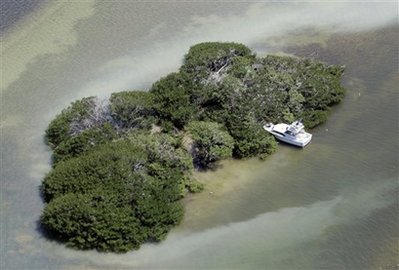Ike roared across low-lying islands Sunday as a Category 4 hurricane, destroying homes, sweeping away boats and bringing more rain to waterlogged communities in Haiti, where at least 48 people died in the floods.
Slamming into the southern Bahamas, Ike bore down on Cuba on a path that could hit Havana head-on, and hundreds of thousands evacuated to shelters or higher ground. To the north, residents of the Florida Keys fled up a narrow highway, fearful that the "extremely dangerous" hurricane could hit them Tuesday.
At least 48 people died as Ike's winds and rain swept Haiti, and a Dominican man was crushed by a falling tree. It was too early to know of deaths on other islands where the most powerful winds were still blowing.
 |
|
A boat takes cover in a mangrove in the Florida Keys, Sunday, September 7, 2008, as Hurricane Ike approaches. [Agencies]
|
The center of the hurricane hit the Bahamas' Great Inagua island, where screaming winds threatened to peel plywood from the windows of a church sheltering about 50 people, shelter manager Janice McKinney said.
"Oh my God, I can't describe it," McKinney said, adding that the pastor led everyone in prayer while the winds howled.
At 5 p.m. EDT (2100 GMT), Ike weakened slightly to a Category 3 hurricane as it bore down on Cuba, still about 75 miles (120 kms) from Guantanamo and moving west at 14 mph (22 kph). Its eye was west of Great Inagua Island in the southeastern Bahamas, with maximum sustained winds of 120 mph (195 kph).
"All we can do is hunker down and pray," reserve police officer Henry Nixon said from a shelter on Great Inagua where about 85 people huddled around a radio.